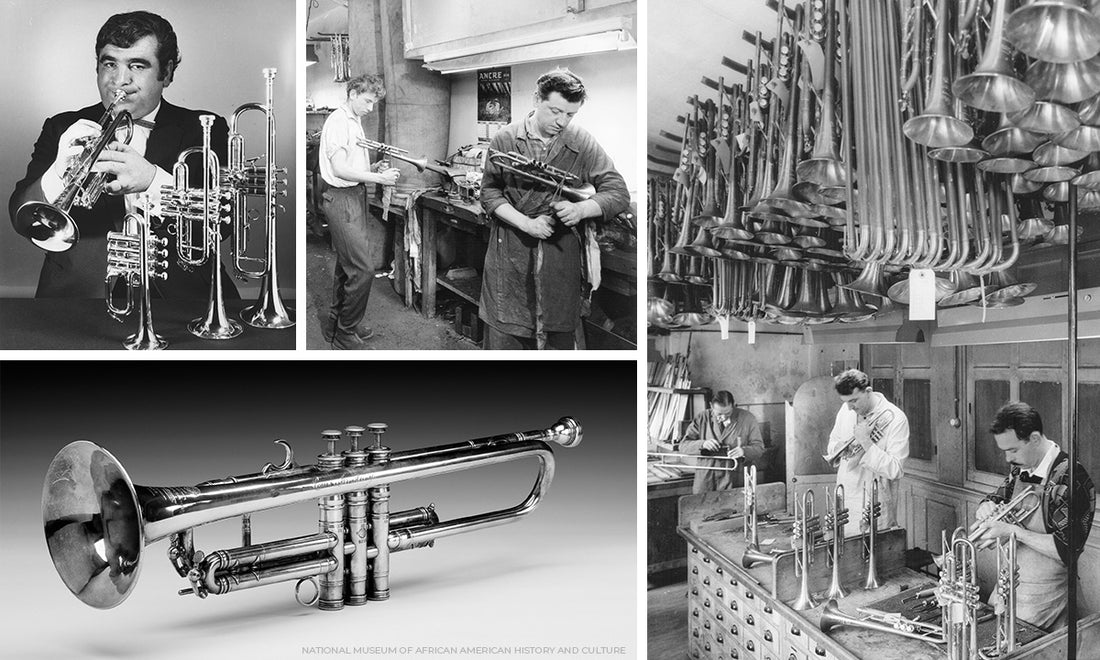The History of SELMER Trumpets

The Genesis of SELMER Trumpets
Founded in 1885 in the Montmartre district of Paris by clarinetist Henri Selmer, the company began its activity by manufacturing reeds and mouthpieces, before designing its first clarinets at the end of the 19th century. The company's success and demand were such that its Paris premises ran out of space. In 1919, the manufacturing workshops moved to Mantes-la-Ville (near Paris), where they are still located today.
At the time, the site was chosen for its proximity to the Seine and the Saint-Lazare train station, thus facilitating the transport of raw materials and finished instruments. This strategic location also meant easy contact with Parisian musicians, particularly those frequenting the Rue de Rome area, known for its many musical instrument shops.

But back to our trumpets! The story begins in 1929, when Henri Selmer acquired the Adolphe Sax & Cie workshops, located in the 18th arrondissement of Paris, incorporating its staff and expertise. This acquisition not only enabled the founder to become the successor of the inventor of the saxophone, but also to start making brass instruments, a Sax speciality at the time. Two years later, the company also bought out the Millereau workshops, another brass manufacturer. Trumpets, trombones, flugelhorns and horns are gradually finding their way into the catalog.

The Balanced TrumpetOriginally launched under Armstrong's name in 1933, this instrument represented a major advance in trumpet design. Louis Armstrong, an ardent fan of the trumpet, referring to it in his recording of Laughin Louie: “My little Selmer trumpet, bless her little heart”.
|
The Evolution of Models

Over the decades, SELMER has constantly innovated in the design of its trumpets, adapting its instruments to changing musical tastes and musicians' needs.
Until the 1950s, production was mainly oriented towards jazz, with the brand enjoying a good reputation in the United States, thanks in particular to the K-modified model designed with Keith Ecker (hence the 'K') and intended for the North American market. As well as modifications to the bores and lengths, which had an impact on tuning, tone and emission, the pistons benefited from a new manufacturing technique and a hard nickel finish to ensure smooth, consistent sliding.
Classical music was not neglected. In 1950, Raymond Sabarich, first trumpet teacher at the Paris Conservatoire, became artistic advisor to SELMER. His student, the illustrious Maurice André, succeeded him in 1966 and helped create the modern four-valve piccolo trumpet. This model, still considered a benchmark in terms of accuracy, projection and centred sound, enabled Henri SELMER Paris to establish itself as the leader of the piccolo trumpet. The collaboration lasted until 1985, when Guy Touvron took over - he was involved in the development of the Chorus trumpets.
In 2010, SELMER presented its latest model, the Sigma trumpet.

Many artists play or have played SELMER trumpets in the course of their careers: Louis Armstrong and Maurice André of course, who contributed enormously to the instrument's worldwide popularity, but also Claude Egéa, Airelle Besson, Fabien Mary, Sylvain Gontard, Stéphane Belmondo, Trombania (Fabien Bollich, Charly Villoteau, Emmanuel Collombert, Clément Saunier, Rodolph Puechbroussous), Raymond Sabarich, Guy Touvron, Ed Anderson, Dwight Adams, Nassim Maalouf, Keyon Harrold, Piotr Wojtasik, Les Trompettes de Lyon (Pierre Ballester, André Bonnici, Didier Chaffard, Ludovic Roux and Jean-Luc Richard), Crystal Torres (none other than Beyoncé's trumpet player)…
Looking for a Second-Hand Trumpet?
 Would you like to buy a Selmer trumpet? Don't hesitate to consult our online advertisements on ReWIND.fr . Would you like to buy a Selmer trumpet? Don't hesitate to consult our online advertisements on ReWIND.fr . Launched by Henri SELMER Paris in 2021, REWIND.fr is the reference platform for second-hand SELMER instruments. These instruments are fully overhauled in our workshops and guaranteed again.
|
This article was written for the 9th issue of Trompettiste(s) Magazine. Proposed by L'Union des Trompettistes, this media is released every quarter, do not hesitate to subscribe.